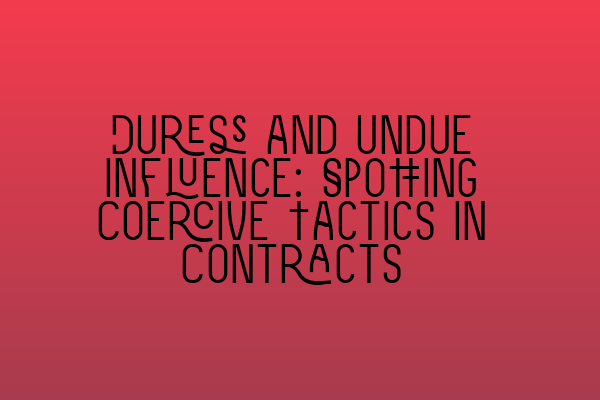Duress and Undue Influence: Spotting Coercive Tactics in Contracts
Introduction:
Contracts form the backbone of legal agreements in various aspects of life, from business transactions to personal arrangements. However, sometimes, contracts may be entered into under duress or undue influence, where one party exerts coercive tactics to manipulate the other party’s consent. As a solicitor, it is crucial to be able to recognize and address such situations to ensure fairness and uphold the principles of contract law. In this blog post, we will explore the concept of duress and undue influence, highlighting the key differences between them and providing insights on how to identify coercive tactics in contracts.
Understanding Duress:
Duress refers to situations where a party is forced into a contract against their will due to the threat of harm or another form of coercion. It can involve physical, financial, or emotional pressure exerted by the other party. In cases of duress, the consent given by the coerced party is considered invalid, rendering the contract unenforceable.
Signs of duress within a contract may include:
1. Threats of physical harm or violence towards a person or their property.
2. Economic duress, such as putting the person in a financially vulnerable position or withholding essential resources.
3. Psychological manipulation or emotional abuse that affects a person’s decision-making ability.
It is crucial for a solicitor to carefully examine the circumstances leading to the contract and determine whether duress was a factor. This is especially important when drafting or reviewing contracts involving vulnerable individuals or situations where power imbalances may exist.
Recognizing Undue Influence:
Undue influence occurs when a party exploits their position of power or trust to manipulate the other party’s decision-making process. Unlike duress, undue influence does not involve threats or coercion but relies on persuasion, deception, or abuse of trust. In such cases, the consent given by the influenced party may not be entirely free, making the contract potentially voidable.
Key indicators of undue influence in contracts are as follows:
1. The presence of a confidential or fiduciary relationship where one party has control or influence over the other.
2. The use of excessive persuasion or flattery to overcome the other party’s objections or reservations.
3. Manipulating the other party’s emotional state or exploiting their vulnerabilities to gain an unfair advantage.
As a solicitor, it is essential to be cautious when dealing with situations involving vulnerable individuals, individuals with diminished capacity, or contracts where a power imbalance exists. Recognizing signs of undue influence can help protect your client’s interests and ensure the validity of the contract.
Protecting against Coercive Tactics:
To safeguard your client’s rights and interests, you need to be proactive in spotting and addressing coercive tactics in contracts. Here are some steps that can be taken:
1. Thoroughly review the contract: Scrutinize the terms and conditions, paying attention to any imbalances, unfair provisions, or heavily one-sided agreements.
2. Assess the circumstances: Examine the background and context leading up to the contract. Look for any signs of duress or undue influence, such as sudden changes in behavior, suspicious timing, or pressure from outside parties.
3. Interview all parties involved: Conduct interviews with all parties to ensure a comprehensive understanding of their intentions, concerns, and level of consent. Financial or legal advisors, if present, may provide additional insights.
4. Consult legal precedents: Research relevant case law and legal precedents to strengthen your argument if you suspect duress or undue influence. This will help you build a strong case to safeguard your client’s interests.
Conclusion:
Understanding and identifying duress and undue influence in contracts is essential for solicitors to ensure fairness, protect vulnerable individuals, and uphold the principles of contract law. By staying vigilant and proactive, solicitors can effectively address coercive tactics and ensure the validity of contracts. If you come across a contract that raises concerns of duress or undue influence, seek professional advice to navigate through the legal complexities and protect your client’s rights.
Related Articles:
– SQE 1 Practice Exam Questions
– SQE 1 Practice Mocks FLK1 FLK2
– SQE 2 Preparation Courses
– SQE 1 Preparation Courses
– SRA SQE Exam Dates
